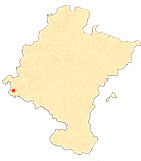Front façade of the parish church of Santa María de Viana
Justification
This is a scenographic doorway, covered by a rich iconography that combines the sacred with the profane, with a highly complex symbolism. This iconography was probably indicated by the bishop of Calahorra-La Calzada Juan Bernal Díaz de Luco (1495-1556), a humanist of great culture. In it we see how scenes of the life, passion and death of Christ are mixed, together with the Assumption and Coronation of the Virgin, prophets and saints, together with pagan themes, with gods and mythological heroes, which offers us classical mythology sifted from a Christian point of view. And all with one purpose, the proclamation of the redemption of humanity through the sacrifice of Christ. Thus, the passages of the life, passion and death of Christ tell us of his sacrifice for the salvation of mankind; the presence of the Virgin Mary indicates her predominant role as intercessor of men before her son; David, St. John the Baptist and Zechariah are prefigurations and precursors of Jesus, who announced his arrival; while evangelists and fathers of the Church are the disseminators and defenders of both the message of Christ and the doctrine of the redemption of mankind through his death. While pagan themes also speak to us of the figure of Christ and redemption. Thus, the scenes of Hercules assimilate the hero par excellence of classical antiquity with the figure of the redeemer, victor of good over evil, in the hope of eternal life after death, embodied in redemption. Likewise, the astrological synastry, besides being the horoscope of the birth and death of Christ, alludes to that celestial space through which Christ passes in his ascension and Mary in her assumption. In short, an iconography that speaks to us of the redemption and salvation of humanity thanks to the sacrifice of Christ, as well as the hope of eternal life thanks to him.
-
ESTEBAN LORENTE, J.F., "El arco de ingreso de la colegiata de Santa María de Viana. Horóscopo de Cristo", Berceo, 130, 1996, pp. 177-178.
-
ESTEBAN LORENTE, J.F., "Los dioses paganos en las iglesias españolas del siglo XVI", bulletin del Museo e high school Camón Aznar, LXXXII, Zaragoza, high school Camón Aznar, 2000, pp. 157-190.
-
FERNÁNDEZ GRACIA, R., (coord.), ECHEVERRIA GOÑI, P.L., and GARCÍA GAINZA, M. C., El arte del Renacimiento en Navarra, Pamplona, Gobierno de Navarra, 2005, pp. 111-114.
-
GARCÍA GAINZA, M. C., HEREDIA MORENO, M. C., RIVAS CARMONA, J. and ORBE SIVATTE, M., Catalog Monumental de Navarra. V. II**. Merindad de Estella, Pamplona, 1980, pp. 559-564.
-
GONZÁLEZ DE ZÁRATE, J. M., "Aproximaciones a la lectura iconográfica del programa mitológico en la portada de Santa María de Viana", Primer congress General de Historia de Navarra, anejo 11, Pamplona, Príncipe de Viana, 1988, pp. 179-196.
-
LABEAGA MENDIOLA, J.C., Viana monumental y artística, Pamplona, Príncipe de Viana, 1984, pp. 229-236.












